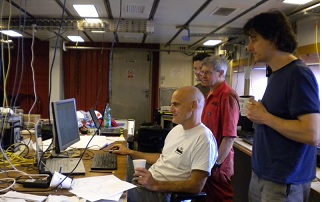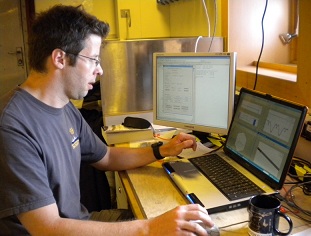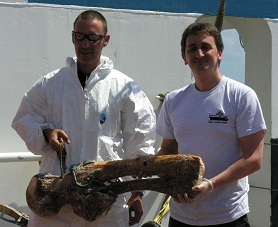Thursday 15th April
HyBIS spent the night visiting our newly discovered deep-sea vents, this time to study their biology. We don't have a complete picture of life at the vents yet, and when we do our biologists will need to analyse it to see how it relates to life at vents elsewhere. Those results will go into a scientific paper, which has to be checked by other scientists before we can talk about it. It is frustrating not being able to share details of the marine life yet, but those are the rules in science!
We caught up with with HyBIS pilot and expedition Chief Geologist, Bramley Murton, on our progress to date. He said: 'Using the approach of zooming in on a particular area in the Cayman Trough has given us a deeper understanding of the geological processes existing here. Starting with the multibeam sonar and TOBI for imagery, and then deploying Autosub6000, has allowed us to dive HyBIS on specific features in a highly constrained way. This has been a fantastic.'
He added 'Achieving high resolution mapping of the vent and tectonic character has revealed some younger volcanic areas, some of which appear in highly unusual parts of the axial valley. We now have a greater understanding of the heat source here: whether it is tectonic mining of heat through the faults, coming from the magma chambers near the surface.'
Autosub6000 was back on deck at 1050h ship's time, and by 1100h we had were looking at the information it had collected. We knew it would be good when Steve, the Autosub6000 team leader, put his head around the door of the main lab saying "you must come and see this..." (probably the quote of the day!)

It only took ten minutes to process the data from the sub because, as Maaten responsible for mission analysis explained, many hours had been spent writing computer programmes to bring together all the information from the sub's systems rapidly into a graph for all to see.

The data from the mission looked great: strong Eh signals, showing chemical changes in the water that suggest there may be yet more vents on the seafloor in another area. This forced a change in plans: another survey with the CTD probe in that location, while Autosub6000's batteries recharged for another mission, taking a closer look at this new target.
Next we deployed the first of our two long-term moorings. This mooring consists of a 1 km long string of instruments, which will monitor ocean currents, temperature and salinity above the ocean floor. It also carries whale bones and wood to see what marine life colonises these resources in the depths of the Cayman Trough, along with another of Alex's microbial colonisation experiments. We will collect the mooring during our next expedition to the area.

Finally, HyBIS went out on another night-time dive, this time loaded with sensors and water collection bottles to study the chemistry of the deep-sea vents.


